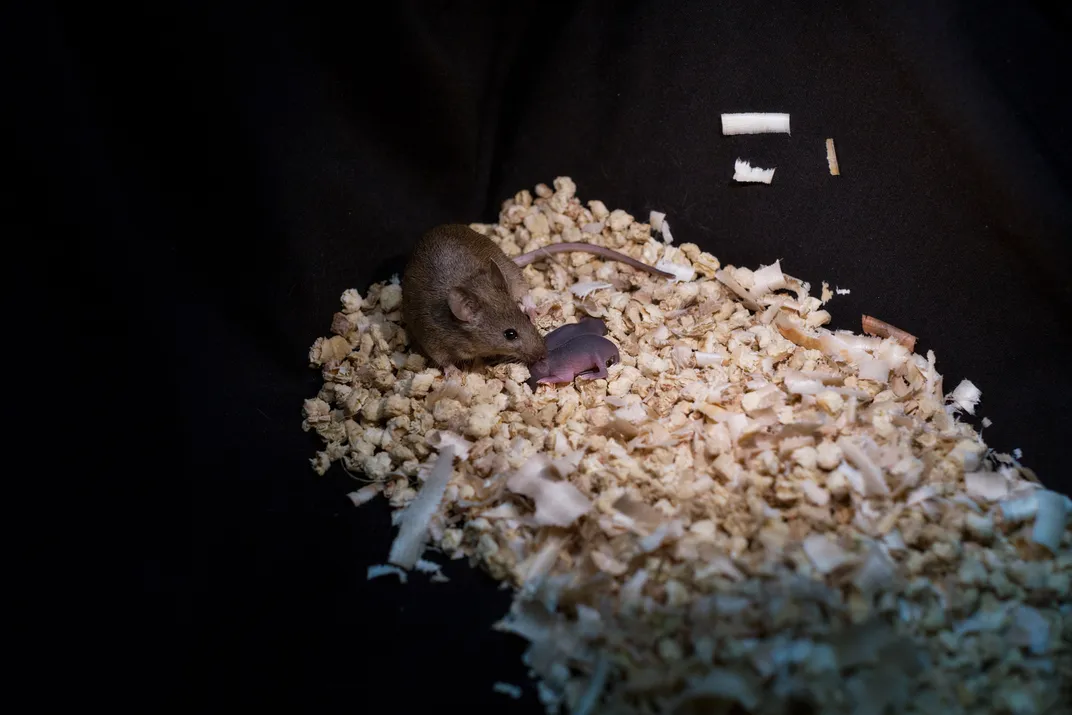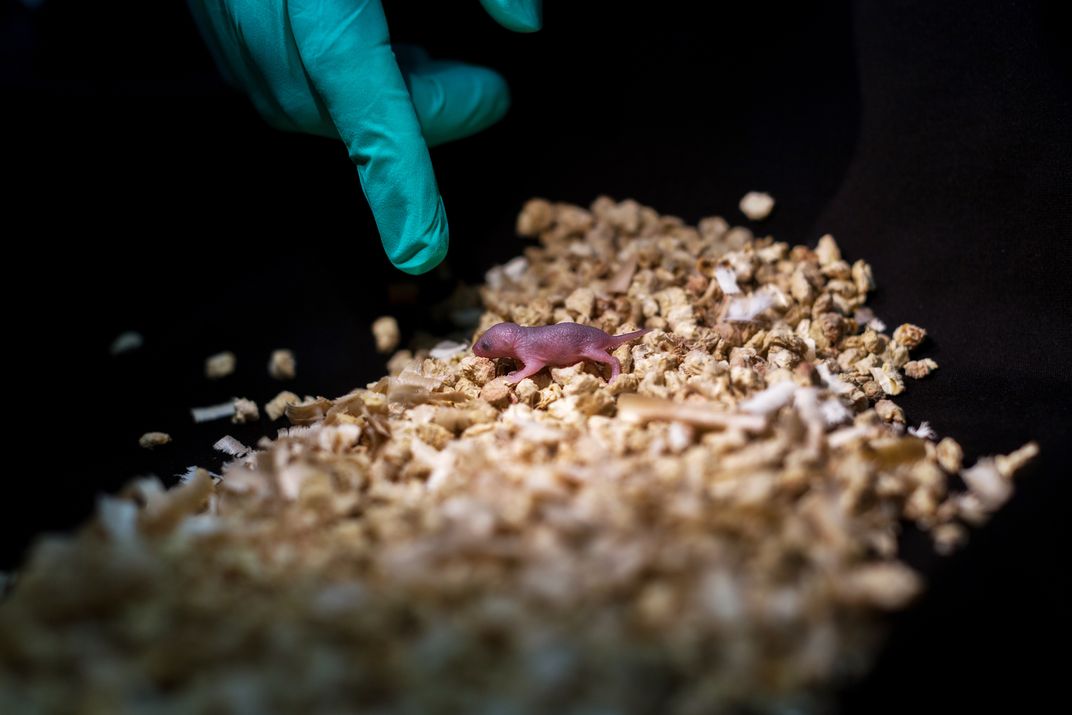Scientists Break the Rules of Reproduction by Breeding Mice From Single-Sex Parents
By tinkering with the genes of sperm and egg cells, it’s possible to breed mice from two females—and even from two males
/https://tf-cmsv2-smithsonianmag-media.s3.amazonaws.com/filer/6b/16/6b16eb39-392a-4c2f-b4e7-64ad7996f860/182387.jpg)
To make a mammal, you need an egg and a sperm. These two required genetic inputs have, historically, meant failure to launch for attempts to produce offspring from male-male or female-female couplings. But by blurring the boundaries between egg and sperm with genetic alteration, scientists are now helping us break the rules of mammalian reproduction.
Yesterday, in the journal Cell Stem Cell, a team of researchers at the Chinese Academy of Sciences reported the birth of healthy offspring to same-sex mouse parents. By modifying the genomes of eggs to resemble those of sperm, and vice versa, the scientists were able to overcome a major hurdle in biological reproduction. Pups from female-female unions survived well into adulthood, even becoming mothers themselves, and short-lived babies were welcomed by a dad-dad duo.
“This is incredibly impressive,” says Ava Mainieri, a biologist who studies the genetics of reproduction at Harvard University. “This technology has about a million implications for the future.”
The researchers were able to overcome a longstanding challenge to producing mammals with single-sex parents. Typically, a mammalian embryo needs two genomes, each containing a manuscript of genetic instructions from the mother or father. In this way, the fetus inherits two copies of each individual gene. But for many genes, either mom’s or dad’s copy goes silent. Entire regions of one genome can be shut down, while those same parts of the genetic code from the other parent remain intact.
“If nucleotides of DNA are a text, [these natural modifications] can be thought of as spaces or punctuation that give meaning to such complicated text,” explains Mainieri, who was not involved in the research.

The challenge is that these spaces and punctuations in each genome need to line up correctly—something that happens naturally with male-female parents. This finicky phenomenon is called genomic imprinting, and it's critical for mammalian reproduction. If both parents’ copies of one of these normally “imprinted” genes is accidentally switched on, the consequences can be disastrous, producing fetuses that balloon in size, struggle to acquire nutrients or even fail to reach term at all.
For scientists trying to breed mammals with same-sex parents, the necessary process of genomic imprinting presents a major hurdle. Around the middle of the 20th century, when scientists made some of the first attempts to produce mouse embryos with two female genomes, it didn’t take long for the math of merging eggs to get messy. Both halves of the genetic instructions reflected maternal imprinting, deactivating and activating the same regions of the genome—and without the paternal part of the equation, some genes were being overexpressed, while others were never properly turned on.
More recently, a cohort of researchers at the Chinese Academy of Sciences led by senior authors Wei Li, Qi Zhou and Bao-Yang Hu decided to try a new set of tools to tackle the issue. Maximizing their chances of producing healthy offspring from same-sex parents meant starting with the least imprinted cells possible—cells that had no punctuation in the genetic code yet. So the researchers generated an unusual set of eggs and sperm by erasing some of the imprinted marks on the genome, essentially turning back the clock on these reproductive cells until they resembled the genetic manuscript’s unedited first draft.
Armed with an arsenal of “clean” cells, the researchers set out to breed bimaternal mice. To mimic maleness, they added their own version of paternal imprinting to a clean egg cell, snipping three known imprinted regions out of its genome. This technique essentially deleted entire paragraphs or chapters from the egg’s genetic manuscript, turning it into a reproductive cell that worked more like a sperm. They then injected the newly manipulated cell into a normal egg from another female mouse.
To their amazement, 14 percent of these bimaternal embryos—29 mice in total—were born healthy females (without a Y chromosome in the reproductive mix, males were a guaranteed nonentity). Several of the bimaternal mice even grew up to birth their own healthy pups (this time through a more natural means of conception). As far as the researchers could tell, the fatherless mice were physically and behaviorally healthy—but Zhou points out that there may be deficiencies in these mice the team hasn’t yet discovered.
An even greater challenge loomed ahead—bipaternal mice. A mouse pup with two mothers had been bred for the first time in 2004 (although with much lower success rates than the newest work achieved). Fatherless mice were, in a way, old news. Motherless mice, on the other hand, would be “amazing,” says Hugo Creeth, whose unaffiliated work at Cardiff University also focuses on genetic imprinting.
One of the major challenges of birthing a mouse with genetic material from two males, according to University of Pennsylvania developmental biologist Marisa Bartolomei, is that there is a lot more imprinting that needs to happen on mom’s genome for it to properly join with dad’s. The extra work required make a male genome behave like a female genome may be part of the reason unisex reproduction in nature slants toward female-female couplings. (While some reptiles, amphibians and fish are capable of female-only mating, just one species—the zebrafish—has ever produced offspring without maternal input, and only in a lab).
“[It seems that] compared to bimaternal reproduction, more obstacles need to be crossed at the bipaternal reproduction barrier,” Li says.
Despite the challenges, the researchers were able to generate live offspring using only DNA from two male parents. A modified sperm cell had six genetic regions removed to make it more closely resemble a female genome, and then was combined with normal sperm inside an empty female egg. (Empty or not, an eggy enclosure is still necessary to bring sperm and sperm together.) These odd hybrid embryos—literal egg shells containing double doses of paternal DNA—were then transferred into a surrogate mouse mother.

Just over one percent of the offspring survived. Sadly, all the pups were born with severe defects and died almost immediately. When the researchers removed a seventh imprinted region from the edited sperm cells, however, they doubled the survival rate. The pups still did not grow to adulthood, but even so, the method had worked, and the offspring’s short-lived viability was monumental.
“This really shows that imprinting is the block to uniparental development,” says Bartolomei. “We’ve known it from the maternal perspective, but now, with the bipaternals, it’s a first.”
According to Li, the next step is to improve longevity for bipaternal mice. It’s still not clear what is killing the mice with two genetic fathers—it’s possible that there are other critically imprinted regions that still need to be genetically “managed,” Bartolomei says.
In fact, it’s a bit of a wonder that so few genetic manipulations were enough to transform the genome of one sex into something resembling the other. There are over 150 genes thought to be imprinted in mice—and the list is ever growing—but not every single one of those genes is critical to birth live offspring.
While the novel genetic modification technique worked to breed single-sex mice, Mainieri cautions that it would require a “huge, huge step” to repeat these experiments in other mammals, including humans. Though Li, Zhou, Hu and their colleagues are eager to someday move on to primates, there’s no guarantee that the markups in one species’ genetic manuscript will easily translate to another’s.
Still, these new findings signify a breakthrough in scientists’ understanding of the role of genomic imprinting in mammalian reproduction. Additionally, there are several disorders that stem from improper imprinting in the genome—so even if motherless or fatherless babies aren’t on the horizon, simply understanding these genetic quirks could change our approach to medicine.
“With this knowledge, we have an ability to read the sentences or paragraphs [of genomic text] in a way that we never have before,” Mainieri says. “And that’s huge.”
/https://tf-cmsv2-smithsonianmag-media.s3.amazonaws.com/accounts/headshot/10172852_10152012979290896_320129237_n.jpg)
/https://tf-cmsv2-smithsonianmag-media.s3.amazonaws.com/accounts/headshot/10172852_10152012979290896_320129237_n.jpg)